The first step is to remove the flywheel. Its good to use a puller for these as they are made out of brass, and mar if you try the smack them with a hammer trick. Then remove the ignition coil itself, it will be the one on top with the light brown wrapping. Its held on with 2 7mm-head bolts.
 |
| From Blog |
The coil is now hanging by two wires (plus the high tension spark plug wire), one wire is 'hot' wire going to the condenser, points, etc. The other wire is the 'ground' wire that ties into the black wire coming out the bottom of the stator plate. Both of these will need to be removed and reconnected or rewired so you can cut them off as close to the coil as possible. The high tension wire coming out of the coil can also be cut off. See where that HT wire ties into the wrapping? Yeah, moisture in there was probably part of the reason you've been having problems. On my bike, before this fix, you could see it sparking all around that shoddy joint.
You can take the removed spark plug wire and use it in your moped voodoo doll, or throw it away. You dont have a moped voodoo doll? Now is the time to make one, treat it kindly and massage in fine scented oils once a week to keep your bike running in tip-top shape.
Back to the coil. Now you are left with just the coil. At its heart this thing is just a hunk of steel with wires wrapped around it. Remember the electro-magnet from 2nd grade science class- it was probably a nail with wire wrapped around it. The coil is the same thing, only instead of using electricity to pick up paper clips, your moped is using a spinning wheel with magnets on it to create an electrical charge in the windings. Basically backwards of what you did in 2nd grade.
Basically, it works like this. The 'coil' has two parts to it, just like your electromagnet. The 'Core' which is the iron or steel chunk in the center (laminated out of sheets of steel to be more efficient) is like your nail. It is the part that becomes magnetized.
The 'windings' is/are the actual wire wrapped around the core. These conduct the electricity just like the wire wrapped around the nail in your magnet.
The four magnets in your flywheel are spinning around your coil. These magnets are oriented in the flywheel to alternate between positive and negative magnetic fields. Each time the flywheel rotates 90 degrees, the direction of the magnetic field in the core switches. When the magnetic field changes, we call that magnetic flux. For some reason the guys from ICP are still trying to figure out, magnetic flux causes an electrical current in the wire wrapped around the core. Electrons get spun around the magnetic field, and the wire develops a potential or voltage.
The amount of power in the wire has to do with several factors. First, the strength of the magnets and the strength of the field in the core. You cant usually make the magnets stronger, but you can make sure this is as strong as possible by getting the core snuggled up real close to the spinning flywheel. Second, the number of wraps of wire around the core. Each wrap contributes a tiny little bit of juice, so more wraps=more power. Finally the gauge of the wire serves as a limiting factor, you can only make as much power as the wire will allow before it melts.
So, back to our Peugeot. This guy is a little bit more complicated than your standard wire-on-a-nail coil as found in puch, minarelli, etc. The high tension coil is wound around the primary coil on the same core. We dont care about that for this article. Cut it all off.
 |
| From Puegeot |
The coil is coated in some nasty epoxy-like crap, a few layers of cotton tape, two layers of wire some very thin and some thicker. There are two phenolic (a brown hard plastic-like material) retainers on the ends, be careful not to break them. I broke one and replaced it with a disc cut out of tupperware lid. I found the quickest way to get the wire off was by slicing it with a dremel, but you could unwind it or cut it with a sharp knife.
When you are done you should have something like this.
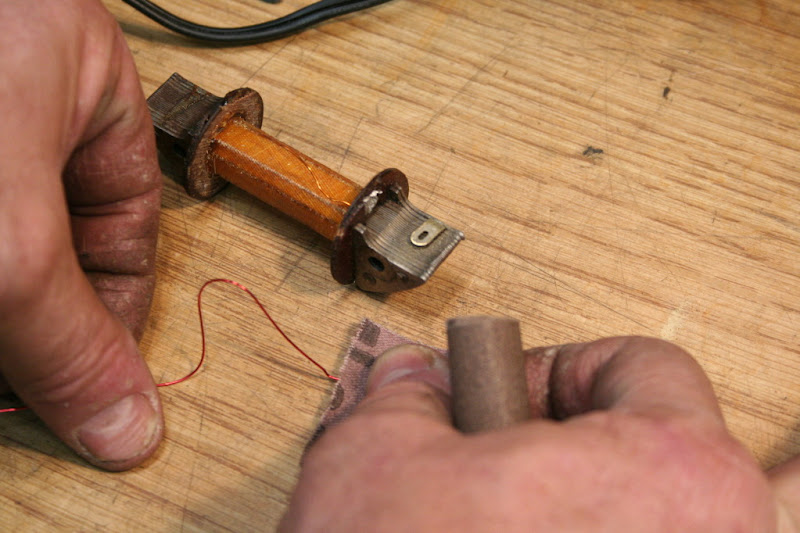 |
| From Puegeot |
If you took the inner layer of fabric tape off the core, thats ok, just wrap it with a layer of hockey tape or something similar. Fabric is preferred to plastic because it will absorb the epoxy when you go to re-pot the coil.
Now a word about magnet wire. Magnet wire is solid copper wire used for winding coils. RadioShack should have it, or better yet search out your local dungeon-esque electronics/radio/etc shop. Most areas have a place like this, forgotten by time somewhere in the Tube era, when people still fixed TV's. Build a relationship with the crumudgeonly old timer behind the counter (if you are lucky he will have thick glasses, suspenders, and a beard). When dealing with electronics like one finds on mopeds, you need someone who knows how things were done 'back in the day' to ask questions of.
If he looks like this - PAYDIRT!
Anyhow, back to the magnet wire. You're looking for 24 gauge, not because that was stock but because thats the fattest wire you can fit the necessary number of wraps on the core. The wire will come insulated with a clear-ish gold/brown or red 'varnish'. You dont want the windings to contact each other, in fact, thats probably why your old coil broke- all that hair thin wire rubbing with every engine vibration.
You will have to sand off a little on the end to solder to that tab on the core. This will be your ground. If you want to keep the stock electrical system with the brake light run from the coil, you could probably slip a little shrink wrap over this and solder it to the 'black' wire... but that system is prone to BS like having your bike not run when your bulb dies, so I prefer the hard ground.
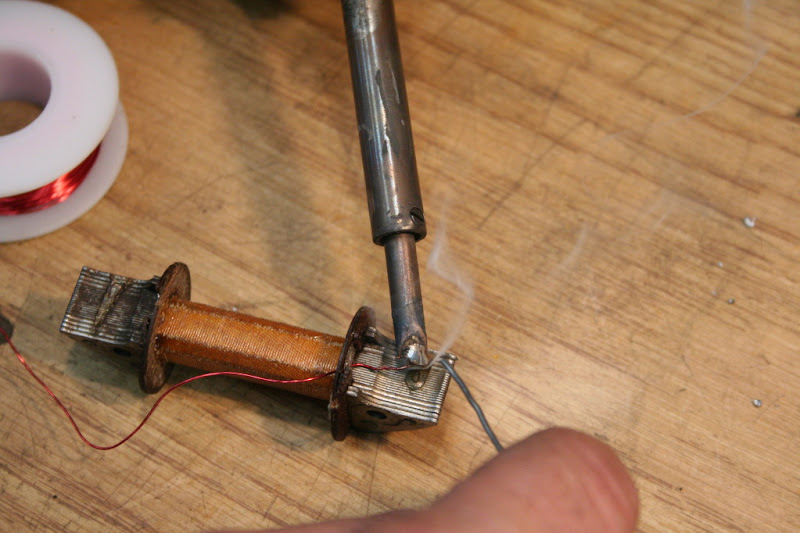 |
| From Puegeot |
Now you will start winding the coil. This is where taking your time is worth it. Nice tight wrappings, evenly spaced, are the key.
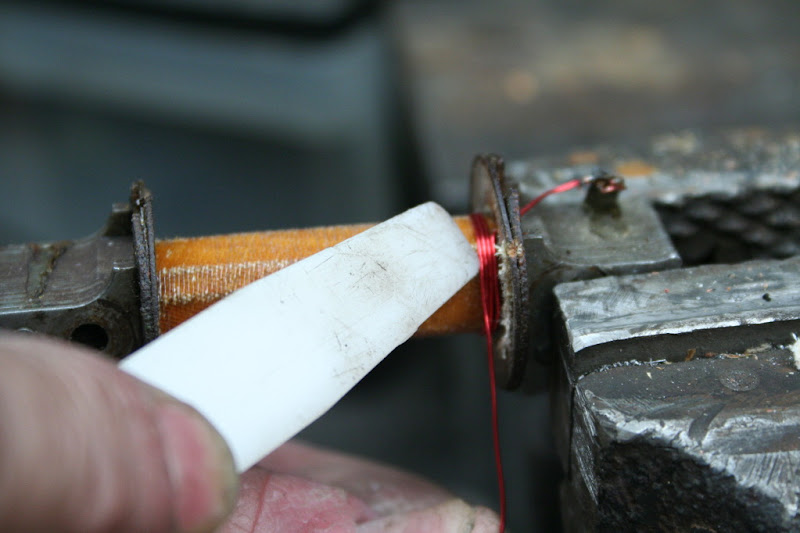 |
| From Puegeot |
You may find it helpful to use a soft tool (something that wont scratch the insulation) to keep the windings tight.
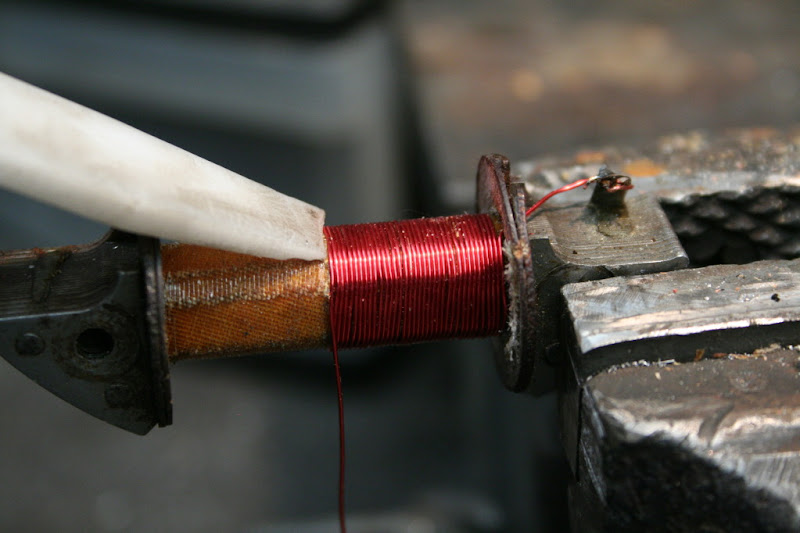 |
| From Puegeot |
When you get to the end, make a nice sharp turn around and come right back. Its important to keep the ends square and even, because they set up the whole next layer and its easy to keep straight once it is on straight, and impossible once it gits wonky.
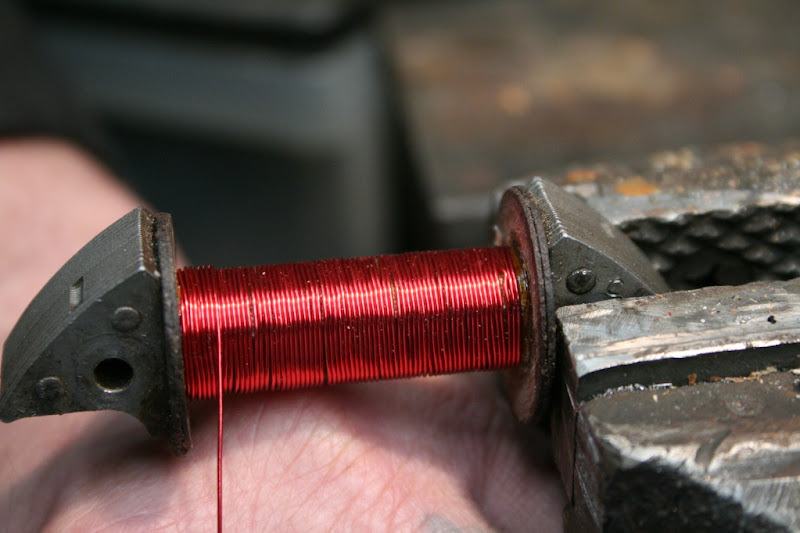 |
| From Puegeot |
Finally you should have something looking like this.
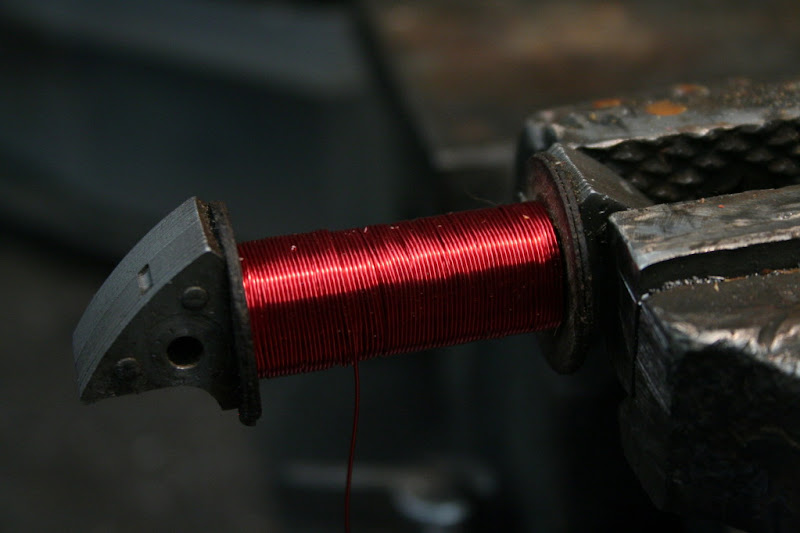 |
| From Puegeot |
You will want to put on about 60 feet of wire, which works out to about 5 layers. This can be a little bit more, but it doesn't need to be, probably shouldn't go much less. What you are really looking for is the resistance of the coil. This will tell you the length of the wire.
Use some tape to hold down the loose end of wire and measure from that end to the ground wire.
 |
| From Puegeot |
You are shooting for 2 ohms. More is OK because it means more wraps, but too much could fry your points or HT coil. Try for 1.8-2.4 ohms.
Finally after winding the coil, wrap some fabric tape around the whole coil. Fabric is the best because it will absorb any potting compound and turn into a fiber-glass like hard shell to protect your electrics.
 |
| From Puegeot |
Now that your coil is all wound nice and tight, you'll have to get the power out of it to the rest of your electricals. You'll be sanding off the insulation again and soldering a lead on to the loose end of the cable. You can also solder it to the stock tab if that is still in place lodged between the layers of phenolic on one of the ends... thats probably the best actually.
 |
| From Puegeot |
The next step will be re-installing the coil. This will be done by running a 'hot' wire out from the soldered tab and cleaning up the stock wiring. You will also have to install the high tension coil. Since the internal coil is designed for a Bosch (puch) system, you can use the bosch coil, or you can use the generic one, or do what i did and get a minarelli/CEV/Ducati coil and the bolt holes line up with the mystery bracket on the swingarm! The new wiring diagram will look something like this:
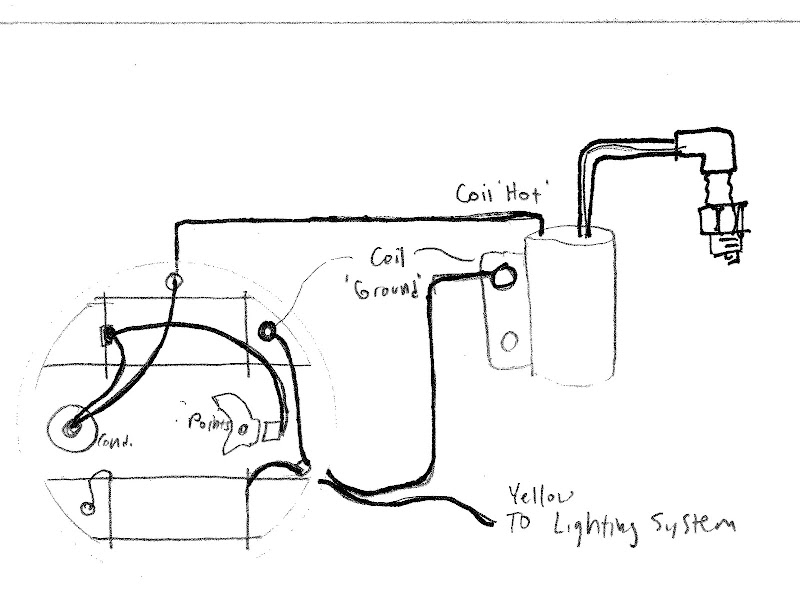 |
| From Blog |
Now, thats a super simplified diagram. I'm going to run a 12v rectifier/regulator on mine for brake, tail and headlights, but you might want to do something different. If you saved a ground lead as seperate you can probably hook that right up to the stock black wire that is there, and get a working tail light or brake light or something.. i dunno. Try it out.
Once everything is together and working, now would be the time to go ahead and pull that coil out enough to pot it. Potting is just applying some sort of glue/varnish/etc to the wires so they dont rub on each other with engine vibration and wear the insulation off. Crazy wayne suggested fingernail polish (you could also add a nice touch of color to your stator this way- use matching shrink wrap tube!) or varnish, polyurethane, epoxy, fiberglass resin, etc. Probably anything that is heat and water impervious.
When you are all said and done, your bike should look something like this... with a nice fat ignition wire that wont get cranky in the rain:
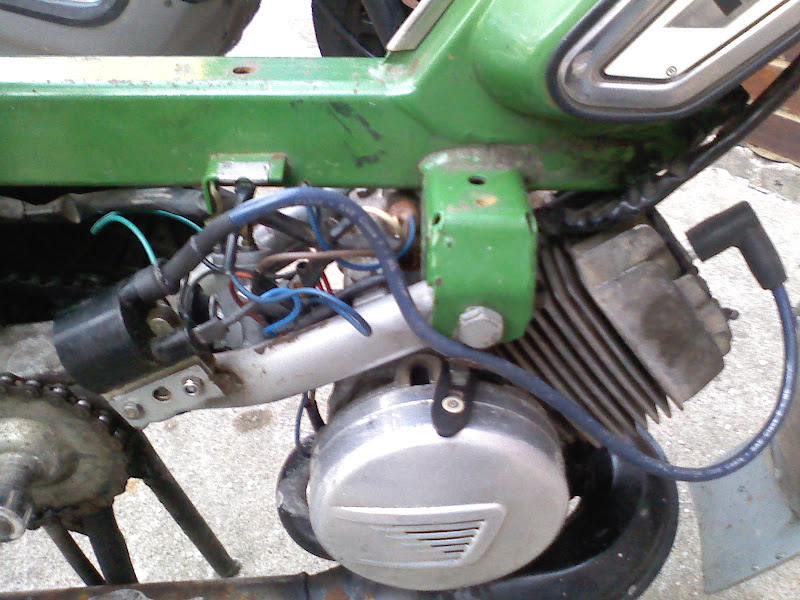 |
| From Puegeot coil re-wrap |
Pro tip: use a little di-electric grease on the spark plug wire when you install it, and finish it with either heat-shrink tube or use the stock rubbers with a tab of silicone gasket seal inside them.
Dont forget to set your timing when you replace the flywheel!
Good luck and happy blastin'
Special thanks to Mark Hand for the excellent photographs and Michael 'mike' Naz advising/answering stupid questions.
for more discussion on coil winding:
Re-wrapping the HPI light coil
Peugeot coil winding success!
